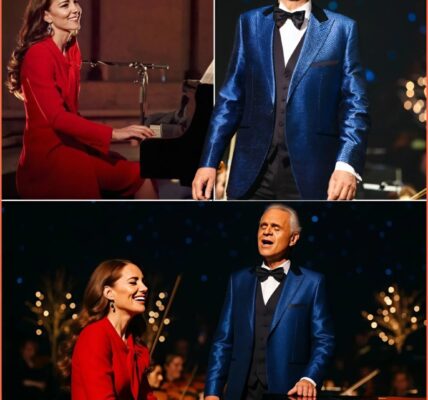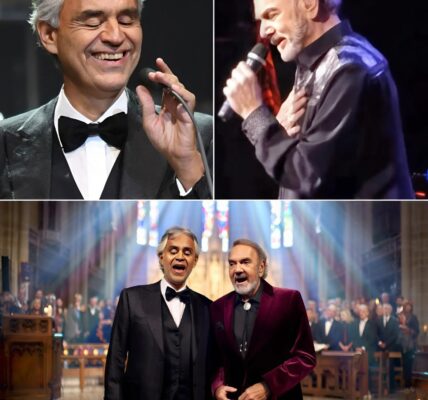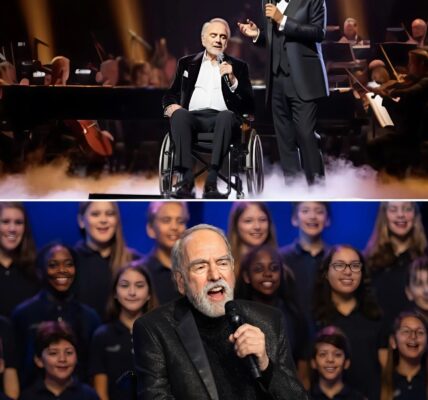At Buckingham Palace, Neil Diamond, 84, sits in a wheelchair, his voice steady but full of emotion, as Andrea Bocelli, visually impaired yet radiant, joins him for a once-in-a-lifetime duet at a private royal gala, the grand ballroom sparkling under crystal chandeliers as royals and elite guests hold back tears. Together, the two legends harmonize timeless classics, their melodies weaving decades of history, love, and artistry into every note, while the audience—senior members of the royal family included—leans forward, captivated by an intimate performance that feels both personal and monumental.
Neil Diamond, 84, and Andrea Bocelli Deliver Heart-Wrenching Gala Performance at Buckingham Palace, Honoring the Disabled and Their Resilience

Buckingham Palace was alight with an aura of reverence and awe as Neil Diamond, 84, made his entrance—seated in a wheelchair, a testament to both age and the physical struggles he now navigates—ready to perform alongside Andrea Bocelli, the legendary tenor who, despite his own visual impairment, commands every note with unwavering precision. The occasion: a private royal gala celebrating music, legacy, and the triumph of human spirit, with the grand ballroom shimmering under crystal chandeliers and a meticulously arranged stage that radiated elegance.
As the first notes of their duet floated across the palace’s historic halls, silence fell. Diamond’s warm, familiar timbre intertwined seamlessly with Bocelli’s hauntingly beautiful voice, producing a harmony that seemed to span decades of artistry, experience, and raw emotion. Royals and elite guests—many attending in formal court dress—watched in rapt attention, some with tears discreetly held back, moved not only by the music but by the sheer courage of the performers. Here were two music icons, both facing personal limitations, turning vulnerability into an awe-inspiring display of human excellence.

Yet the night was never merely about celebrity or spectacle. Behind the scenes, organizers had quietly invited disabled children and adults with special needs to witness the performance up close. For them, this was more than a concert—it was a statement, a recognition that their struggles, courage, and humanity are worthy of celebration. Diamond and Bocelli, fully aware of their audience, performed each note as a gift, a gesture of solidarity, and gratitude. Every sustained chord, every emotive inflection, felt like a direct line to the hearts of those who have faced adversity daily.
Midway through the set, a hush descended when Neil paused, glancing toward a young audience member in a wheelchair. In that fleeting moment, the music slowed; the intimacy of the palace room amplified the connection. Bocelli responded with a tender trill, and together, they seemed to communicate a universal message: despite life’s obstacles, hope, beauty, and artistry endure. The performance became a living testament to perseverance, an example that music can heal, uplift, and unite.
As the evening drew on, whispers circulated among guests that this could very well be the final time these two legends would share a stage in such an intimate setting. For many, the realization heightened the poignancy of each phrase. The palace’s golden chandeliers reflected off polished marble, casting light on a moment that would linger long after the final note faded. Journalists and insiders noted the rare vulnerability displayed by both performers—no grand gestures, no showmanship beyond the music itself—only honesty, dedication, and a shared mission to honor the human spirit.
By the end of the night, the standing ovation was deafening, yet quiet in its dignity. Neil Diamond’s smile, warm but tinged with fatigue, met Bocelli’s serene nod, a silent acknowledgment of a shared journey through decades of music, challenges, and personal growth. For the disabled audience members, for the royal guests, and for the world watching, it was a night where art, empathy, and humanity converged. Buckingham Palace had witnessed not only a historic performance but also a powerful reminder: music is at its most transformative when it bridges differences, uplifts the vulnerable, and celebrates the resilience of the human soul.




